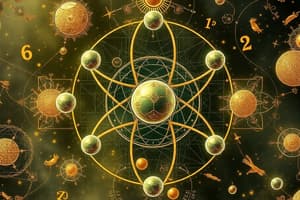Podcast
Questions and Answers
Who proposed the Plum Pudding Model of the atom?
Who proposed the Plum Pudding Model of the atom?
- Niels Bohr
- J.J. Thomson (correct)
- John Dalton
- Dmitri Mendeleev
Which atomic model suggests that electrons orbit in discrete energy levels around the nucleus?
Which atomic model suggests that electrons orbit in discrete energy levels around the nucleus?
- Rutherford's Planetary Model
- Billiard Ball Model
- Bohr's Atomic Model (correct)
- Plum Pudding Model
What fundamental subatomic particle was discovered by J.J. Thomson?
What fundamental subatomic particle was discovered by J.J. Thomson?
- Proton
- Positron
- Electron (correct)
- Neutron
Which quantum number describes the orientation of an orbital in space?
Which quantum number describes the orientation of an orbital in space?
What does the term 'atomic spectra' refer to in the study of atoms?
What does the term 'atomic spectra' refer to in the study of atoms?
Which quantum number describes the orientation of the subshell in a given shell?
Which quantum number describes the orientation of the subshell in a given shell?
In an atom, where do neutrons primarily reside?
In an atom, where do neutrons primarily reside?
Which set of subshells is listed in the correct order of increasing energy?
Which set of subshells is listed in the correct order of increasing energy?
What is the spin quantum number for an electron that has down intrinsic angular momentum?
What is the spin quantum number for an electron that has down intrinsic angular momentum?
How do chemists use atomic spectra to identify and classify elements?
How do chemists use atomic spectra to identify and classify elements?
Study Notes
Unraveling the Structure of Atoms
Atoms, the fundamental building blocks of the universe, have fascinated scientists for centuries. Their intricate makeup is essential to understanding the properties of matter and the behavior of elements in nature. In this exploration, we'll dive into the key subtopics that explain an atom's structure: atomic models, subatomic particles, quantum numbers, electron configuration, and atomic spectra.
Atomic Models
The early conceptualizations of atomic structure date back to Democritus's "atomos" in ancient Greece. However, it was not until the late 19th century that physicists and chemists like John Dalton, Dmitri Mendeleev, and J.J. Thomson refined our understanding of the atom's composition with their various models. The most well-known models include:
- Billiard Ball Model (Dalton, 1803): Atoms consist of indivisible, indestructible units that combine in specific ratios to form compounds.
- Plum Pudding Model (Thomson, 1897): Electrons are embedded in a positively charged, continuous medium.
- Rutherford's Planetary Model (Rutherford, 1911): Electrons orbit a dense, positively charged nucleus like planets around the sun.
- Bohr's Atomic Model (Bohr, 1913): Electrons orbit in well-defined, discrete energy levels or shells around the nucleus.
Subatomic Particles
The atom is composed of several fundamental subatomic particles. The two most essential components are:
- Protons (p+): With a positive charge of +1, protons primarily reside in the atom's nucleus.
- Neutrons (n0): Neutrons have no charge, and they also occupy the nucleus.
- Electrons (e-): These negatively charged particles orbit the nucleus.
Quantum Numbers
Quantum mechanics introduced four quantum numbers to describe the behavior of electrons in an atom:
- Principal quantum number (n): The energy level or shell an electron occupies.
- Azimuthal quantum number (l): The electron's angular momentum and its subshell.
- Magnetic quantum number (m_l): The orientation of the subshell in a given shell.
- Spin quantum number (m_s): The electron's intrinsic angular momentum, which can be up (+1/2) or down (-1/2).
Electron Configuration
An atom's electron configuration describes the arrangement of its electrons in energy levels and subshells. Electrons occupy energy levels based on their increasing energy:
- 1s (first shell)
- 2s, 2p (second shell)
- 3s, 3p, 3d (third shell)
- 4s, 4p, 4d, 4f (fourth shell)
- 5s, 5p, 5d, 5f, 6s (fifth shell)
- 6p, 6d, 6f, 7s (sixth shell)
Electrons occupy subshells in the order of s, then p, followed by d and f subshells.
Atomic Spectra
When atoms absorb or emit light, they undergo transitions in their electron configurations. The unique pattern of wavelengths produced by each element allows chemists to identify and classify elements in atomic spectra. The energy differences between energy levels correspond to the wavelengths of emitted or absorbed light.
In summary, understanding the structure of atoms allows us to comprehend their properties and behavior, as well as the makeup of the world around us. The subtopics outlined, including atomic models, subatomic particles, quantum numbers, electron configuration, and atomic spectra, provide a framework for studying and exploring the fascinating world of atoms.
Studying That Suits You
Use AI to generate personalized quizzes and flashcards to suit your learning preferences.
Description
Dive into the structure of atoms by exploring atomic models from Dalton to Bohr, understanding subatomic particles like protons, neutrons, and electrons, learning about quantum numbers, electron configuration, and how atoms emit or absorb light in atomic spectra.




